SSC working to modernize, improve and build resiliency into space and ground architecture
The world increasingly depends on data — from the GPS signals that navigate location for first responders to shipping, agriculture, and hosts of other industries, to timing signals that help secure financial transactions, to the missile warning and intelligence information that aids warfighters in the field.

While the United States has long enjoyed a competitive advantage through its space-based satellite systems, several factors have created the need for a multi- faceted push within the U.S. Space Force (USSF) to modernize data transport, with Space Systems Command (SSC) as the key driver.
Previously, U.S. satellite communication missions were spread out among the military branches. With the creation of the USSF, those missions are now consolidated under one branch to ensure unity of effort.
Factors driving modernization efforts include rapid improvements in technology that have expanded capabilities; the explosive growth in the number of on-orbit satellites, particularly in Low Earth Orbit (LEO); new partnerships with allies and the commercial space industry; and the need for more resilient systems that can withstand threats from adversaries.
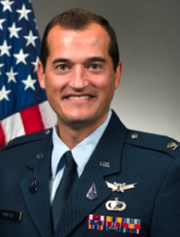
“Many of the components of our data transport system have worked very well, for a very long time,” said Colonel Peter C. Mastro, senior materiel leader, Tactical Command, Control and Communication Delta at SSC. “But now, we’re on the brink of a data transport revolution and SSC is working hard to create a stronger, faster and more resilient system that can meet the threat now — and adapt to the demands of the future.”
Mastro’s work focuses on getting commands to satellites and the connection between satellite ground systems and the satellites on-orbit, as well as the movement of data across terrestrial lines that connect USSF missions together.
Satellites and the ground systems that support them provide a wealth of critical data: position, navigation and timing (PNT); intelligence, surveillance and reconnaissance (ISR); missile warning and missile defense; communications, weather; and research and development (R&D).
It’s not just about providing data during a conflict; a host of other government agencies — from the National Reconnaissance Office (NRO) to the National Oceanic and Atmospheric Administration (NOAA) — depend on data provided by the USSF.
The backbone of the system is the Satellite Control Network (SCN), which was first established in 1959. The SCN is a worldwide system of 19 antenna stations in seven separate geographical locations that track Department of Defense (DoD) and other government agencies’ satellite locations, collect data on the satellites’ status and send control commands to various sub-systems. SCN is also an important part of launch support and provides emergency support for lost or out-of-control satellites.
“You can think about it like the Space Force is operating a drone — this drone (satellite) just happens to be on-orbit,” Mastro said. “You have to be able to send it commands to do things, to turn on payloads like the communication radios. Or, if it happens to have a camera on board or, for our missile warning satellites, an imager, point it in the right direction. And then you have to be able to monitor the satellite, that all the subsystems are working as we expect them to be,” Mastro said. “That temperature readings are all staying in the bounds as they go around the earth and get exposed to the sun and then go into the shadow.”
Mastro continued, “When you collect the data, you also have to contact the satellite. All of that data needs to get down to the ground and processed, typically through the mission-unique antennas we have.”
However, the SCN antenna stations communicate with satellites using parabolic antennas and can only communicate with one satellite at a time — and only within a limited window of time when that satellite is in range of the antenna.
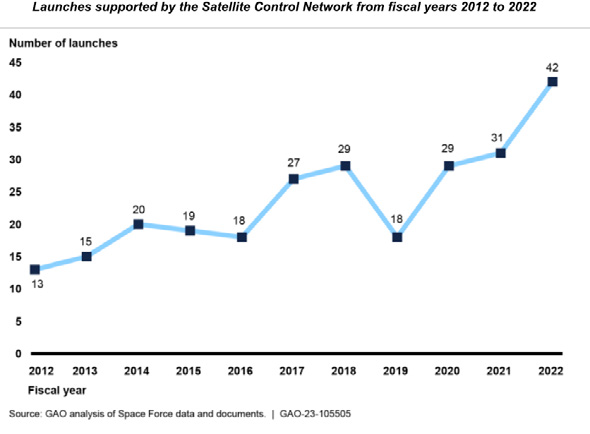
As the number of active payloads increases, demand for those communication slots is skyrocketing.
“With the existing SCN antennas, they talk to one satellite at a time,” Mastro said. “And as we launch more satellites, that starts to put a capacity burden on the number of satellites that we can actually talk to.”
An April 2023 report from the U.S. Government Accountability Office (GAO) estimated that the SCN averaged more than 164,000 contacts with satellites per year, or about 450 a day.
The GAO also noted that the utilization rate for the SCN has averaged 75% over the last decade — exceeding the 70 percent level cited by USSF as the threshold used by the commercial industry to indicate the need for more capacity.
However, Mastro added that figure is an overall average capacity metric: there may be some specific geographic areas and times during which, “the network may be maxed out, and there may be space vehicles that want a particular contact, and they are turned away from the SCN because there isn’t capacity to help them.”
Priority is set by SSC, and if, for example, a communications satellite needs a slot at the same time one of the missile warning satellites requires access, then the communication satellite may need to wait for a later time slot, Mastro noted.
From 2021 to 2022, there were more than 15,000 “conflict deletes” where SCN operators were unable to accommodate specific requests, according to the GAO.
But USSF and SSC have launched multiple efforts to improve the way the Space Force can communicate with the increasing number of satellites, including expanding the number of antennas the USSF can access.
Under the Federal Augmentation Services system, USSF gets access to antennas owned by NOAA, and if those antennas are underused, the USSF is able to use them, Mastro said, adding, “That way, the federal government is more efficiently using the resources that we have so we don’t have to go out and buy more — we just better share what we have across our federal agencies.”
Another project underway is the Satellite Communication Augmentation Resource (SCAR), a phased-array antenna that would be capable of as many as 10 simultaneous contacts. Unlike a parabolic antenna, a phased array panel has a flat panel that receives and transmits from multiple beams, Mastro said.

“SCAR is a Space Force-built, Space Force-owned antenna — development and delivery is being run by the Space Rapid Capabilities Office,” Mastro said. “When they develop and deliver that, it’s going to be absolutely outstanding and will drastically increase the number of simultaneous satellite contacts the Space Force will be able to do.”
SSC has continued to develop partnerships with the commercial space industry as part of its “exploit what you have, buy what you can, and build what you must” strategy, and that includes the field of data transport. But Mastro noted there are some limitations. “We have been working to get access to more of the commercial network antennas that are out there. But there are a few things that Space Force satellites require that are difficult to find in the commercial market.”
One critical factor is that almost all USSF satellites communicate on a specific frequency for uplink and downlink and a specific waveform, SGLS. (additional information on SGLS is available at this Space Foundation infosite link).
Although USSF is adding more satellites to LEO to make their systems more resilient, it also has a number of satellites in Medium Earth Orbit (MEO) and Geosynchronous Orbit (GEO) and many of the available commercial antennas aren’t sized — either in their physical size or their power — to handle transmissions to those orbits, Mastro said.
“That waveform has been used by the Air Force, and now the Space Force for decades, and is not supported by commercial providers — outside of the Space Force, nobody really uses that standard,” Mastro said. “But nearly all of our satellites need to communicate in that waveform.”
“As we look to expand out and get access to commercial antennas, we either have to only use those antennas to communicate to a very small number of Space Force satellites or you end up having to do things like modifying commercial antennas to meet your requirements,” Mastro said. “You could also commercial antennas to meet your requirements,” Mastro said. “You could also change the satellites to communicate on a commercially used waveform, and the
USAF/USSF has had efforts in the past to make that change. The entire point of going to commercial providers is that (the product) exists already and you can expand quickly. But if they don’t transmit or receive at the right frequency, then we can’t just use them as is.”
“We do believe getting commercial antennas connected into Space Force operations to a greater degree than we have right now is part of what we are trying to achieve,” Mastro said. “It’s just one example of how the Space Force operates differently than commercial industry that makes it a little more difficult than just saying we can turn it all over to commercial.”
However, partnering with the commercial space industry is an important way the Space Force can ensure that it has the newest, best, and most innovative technology, Mastro said, and in many cases, commercial partners have been able to tailor a product to the military’s unique requirements for security — either for the end capability itself or the defense of that capability.
One example of a successful commercial partnership has been MeshONE-T, a multi-node, software defined, wide-area network that partners with Defense Information Systems Agency (DISA), as well as commercial providers of long-haul terrestrial communication to provide those data transport services to different mission areas that need it, Mastro said. DISA provides a global infrastructure for information sharing and communication, across the DoD.
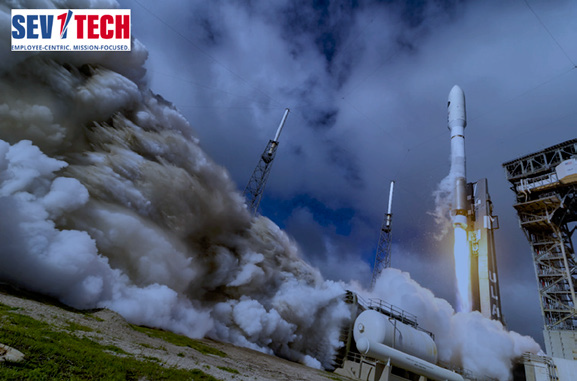
The project originally started two years ago with Sev1Tech to develop a prototype for a modern, resilient, scalable, and secure data transport network.
This prototype will be designed to connect across the Space Force, U.S. Air Force (USAF) and, ultimately, other branches of military service, and lead into the Joint All-Domain Command and Control (JADC2).
“We are building out this Mesh network of long-haul data transport that has all the modern cybersecurity capabilities, has Zero Trust capabilities embedded in it, and it provides resilient pathways,” Mastro said. “Currently, it’s all terrestrial fiber optic paths, but we will be expanding into MILSATCOM connections as well as connections through commercial, proliferated LEO. So we will have even more diversity and resiliency in the way the Space Force moves data.”
Mastro said SSC has collected requirements from mission partners across the USSF and has been working to roll out capabilities to them. Currently, there are 17 worldwide deployed nodes at different bases around the world.
“So many programs out there have to figure out how to move data and turn to DISA,” Mastro said. “DISA is an outstanding partner in providing that support, but now with a program like meshONE-T, if there is any individual program that should be focused on their mission, they can turn to meshONE-T and meshONE-T can handle all the details around how to move that data. MeshONE can work with DISA, meshONE-T can work with the commercial satcom through proliferated LEO. And we can provide, in partnership with DISA, something that is even more resilient than the mission unique program would otherwise obtain.”
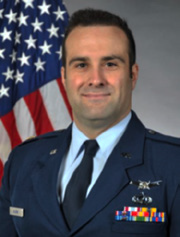
“If I wanted missile warning data, even though I’m on a U.S. Space Force base, I can’t plug into a wall jack and get SBIRS (Space Based Infrared System satellite) data,” said Lieutenant Colonel Louis J. Aldini, Materiel Leader, Information Mobility at SSC.
“With meshONE-T, data is now more readily available to different mission users at USSF and other locations,” Aldini said. “You can plug into a meshONE-T node, and if SBIRS is a mission user on there, you’re that much closer to getting the data. We don’t allow instant access for cyber reasons, but just by offering that capability, we’ve shortened timelines down from months to possibly days.
meshONE-T also provides enhanced data transport resiliency and path diversity across the architecture.”
“My office is focused on making sure data transport is more seamless and more of a commodity for multiple different missions to use, as opposed to having individual programs architect solutions for themselves,” Aldini said. “They hand over their needs and requirements and we provide the solutions.”
SSC also is taking a multiple-pronged approach to replacing the current, manually operated DOS-based SCN scheduling system, which has been in place since 1991, Mastro said.
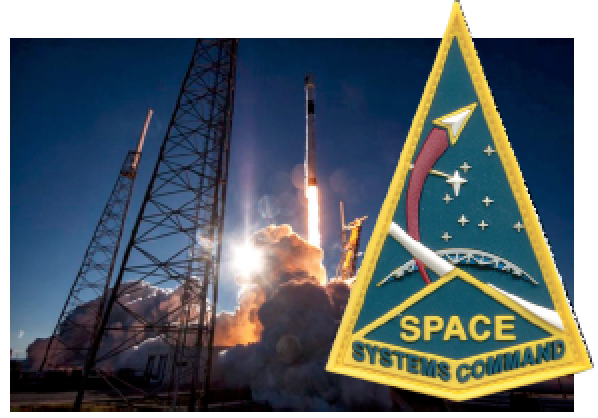
“Sometimes with a capability like our antenna network, it is more difficult to get that high priority in funding decisions in comparison to some of the end operational capability,” Mastro said. “Over the years, there has been an under- investment in the SCN.”
Next year, SSC will replace it with AST (AF(SCN) Scheduling Tool) which will put the system on a modern infrastructure. After that, SSC will roll out Enterprise Resource Manager (ERM) a Cloud-based system “which will really automate the way we do scheduling, not just across government-owned antennas, but also across commercial and other federal network antennas,” Mastro said. ERM is expected to be launched sometime in 2028.
“We have a lot going on,” Mastro said. “We’re improving multiple pieces of it, all in parallel.”
Space Systems Command is the U.S. Space Force field command responsible for acquiring, developing, and delivering resilient capabilities to protect our nation’s strategic advantage in, from, and to space. SSC manages a $15 billion space acquisition budget for the Department of Defense and works in partnership with joint forces, industry, government agencies, academic and allied organizations to outpace emerging threats. Our actions today are making the world a better space for tomorrow. Contact Space Systems Command at SSC@spaceforce.mil and follow on LinkedIn.

